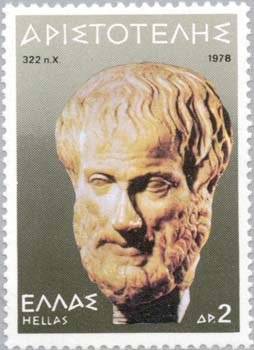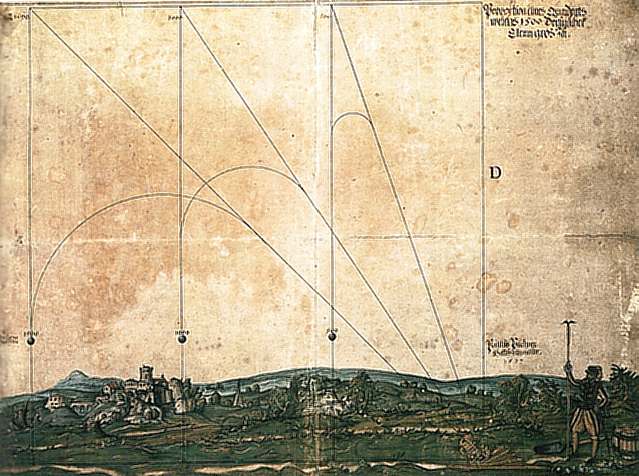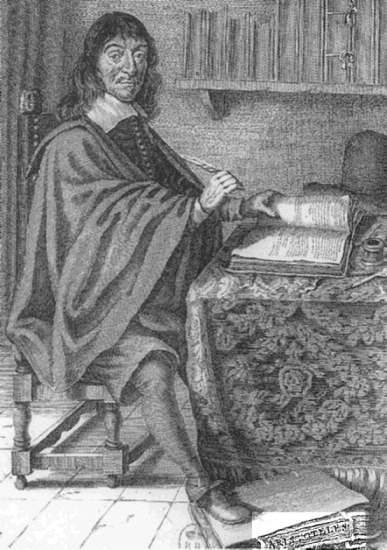.
Die Physik von Aristoteles
The word “physics,†comes from the Greek word phusis. This is usually translated as “nature,†but not nature in the sense that we usually use the word. Aristotle might say that phusis is the internal activity that makes anything what it is. Our word for nature comes from Latin roots having to do with birth and growth, and these associations are present in the Greek word as well. It is in the “nature†of a human embryo to develop into a fetus, to be born, and eventually to become a mature human being. This is the internal activity that makes it what it is. One of Aristotle’s most influential books is entitled simply Phusis, or as it is always translated, Physics. Alfred. W. Stetz , Beginning with Aristotle, Life, the Universe and Everything

Aristotle
Something which we have to recognize is the investigation method of Aristotle that is actually not really different than used in any scientific publication today. He defined the subject matter, discussed the ideas and work of others on the subject being critical with logical problems of their models, and finally he presented his own views and possible solutions.
Before anything else, I may say that the old theories are crude and inexact. Men were still in error about the truth. Everything was new for men who were making the first attempts. Later these same theories were refined. Yet if anything has been discovered, it none the less ought to be acknowledged as having been received from them. It was the achievement of a great spirit to move aside the veil from hidden places and, not content with the exterior appearance of nature to look within and to descend into the secrets of the gods. The man who had the hope that the truth could be found made the greatest contribution to its discovery. And so the ancients must be listened to, indulgently Nothing is completed while it is beginning. This is true not only in this subject (which is the greatest and most complex of all), but in every other business as well. Even though much will have been done on the subject every age will none the less find something to do. As in every other subject, the first beginnings have always been far away from the completed knowledge! Seneca Natural Questions
Aristotle, according to Dante The master of those who know, was for almost 2000 years up to 1700 AD the most important scientist. He was a philosopher, biologist, physicist, mathematician (logic), he wrote on Ethics, on Drama, History of Science etc. He was a unique scientist in many fields where today only specialists exist. As someone said scientists today know everything about nothing. Aristotle's two most important known works on physics are - Physics and On the Heavens.
The man was born, he worked, and then died. Martin Heidegger, German philosopher, A short biography of Aristotle presented in a lecture.
The cosmos according to Aristotle is build by four elements plus the quintessence. Bodies have a natural tendency to be at rest special towards the center of the earth and only the ground hinders this, explaining in this way gravitation. This tendency was different for lighter objects such as fire and air. Why does an arrow not fall directly after thrown he describes by a mechanism that the air in front is compressed and pushes somehow the arrow further until this mechanism is too weak and the arrow stops. The trajectory history is divided in the initial violent part and the end represents the natural motion towards the center of the earth.
Strato of Lampsacus who was for a time a teacher of Philadelphus, the son of Ptolemy I Soter, and head of the Lyceum after Theophrastus did a series of experiments that convinced him that Aristotle's opinion was wrong.

Trajectories of projectiles according to Aristotle's Impetus Theory (that was modified and extended later by Burridan).
Today it is easy to say that his ideas in physics were completely wrong. The physicist J. D. Bernal says in Science in History (1969 Penguin). "Bruno had to be burnt and Galileo condemned before doctrines which were derived from Aristotle could be overthrown. The subsequent history of science is largely, in fact, the story of how Aristotle was overthrown in one field after another. Indeed Ramus was not far from the mark when he maintained in his famous thesis of 1536 'that everything Aristotle taught is false'." So it is easy to say that Aristotle is responsible that Physics did not evolve for 1700 years, whereas the question is why did nobody any experiment for such a long period to show that some of his ideas are wrong?
He was a bit of a dandy, wearing rings on his fingers and cutting his hair fashionably short. He suffered from poor digestion, and is said to have been spindle-shanked. He was a good speaker, lucid in his lectures, persuasive in conversation; and he had a mordant wit. His enemies, who were numerous, made him out to be arrogant and overbearing. ... As a man he was, I suspect, admirable rather than amiable.
J Barnes, Aristotle (Oxford, 1982)
The anecdotes related of him reveal him as a kindly, affectionate character, and they show barely any trace of the self-importance that some scholars think they can detect in his works. His will, which has been preserved, exhibits the same kindly traits; he makes references to his happy family life and takes solicitous care of his children, as well as his servants.
Encyclopedia Britannica
Aristotle’s laws of motion are:
1.The speed of falling is proportional to the weight of the object. Heavier things fall faster.
2.The speed by which an object falls depends inversely on the density of the medium it is falling through.
Because of his two laws of motion Aristotle rejects the “voidâ€, because a void would be incompatible with his notion of how things move. According to Aristotle, something moves faster the less resistance it feels. Therefore, it would move infinitely fast in a vacuum. Aristotle considered that always there is some friction.
A study of moving bodies had led Aristotle to conclude that for a given force or impulse the velocity was in all cases inversely proportional to the density of the medium - such as air or water - through which the object moved. In modern symbolism this principle may be represented in the form of an equation v = k/d, where v, the speed, is a function of d, the density of the medium, and k is a factor of proportionality. Aristotle then raised the question as to what would be the speed of a body in a vacuum - that is, when d = 0. In answer he wrote: Now there is no ratio in which the void is exceeded by body, as there is no ratio of 0 to a number. For if 4 exceeds 3 by 1, and 2 by more than 1, and 1 by still more than it exceeds 2, still there is no ratio by which it exceeds 0; for that which exceeds must be divisible into the excess + that which is exceeded, so that 4 will be what it exceeds 0 by +0. For his reason too a line does not exceed a point - unless it is composed of points! C. B. Boyer, An Early Reference to Division by Zero, The American Mathematical Monthly, Vol 50 No 8 , 1945, pp. 487-491
Aristotle said that things move at a constant velocity because there is some action (force) that is keeping the constant motion. This is incompatible with the first law of Newton, that any body will continue in a straight line with a constant velocity, if left to itself. We will get to this later, but of course these early ideas are in accord with what one often sees everyday, especially at that time.
We can claim that Aristotle did no experiments to verify his “lawsâ€. Probably because he was not an engineer and because he considered this not to be necessary and logic to be enough. Even today a majority of physicists believe exactly this. They develop models based completely on mathematics and hope that some experiment will show that their ideas are correct. Of course they have some knowledge of experimental results or theories that are confirmed by experiments. They are in a better position than Aristotle in this respect. At least from the developments of the catapults we know experiments were performed by ancient Greeks to increase the effectiveness of these weapons. Empirical laws have been found by these experiments that were reproduced later by Hook. We also have to consider that Aristotle obtained his results from observation of natural phenomena. He did not have experimental methods to produce a vacuum or to reduce the friction to observe the dependency on the density.
Aristotle did not accept the heliocentric model because he assumed that the centripetal acceleration would cause objects on the earth to fly off at night. The effect is real we do weight less at night than at day for this reason. But the effect is small compared to the earth's gravity which keeps us on the ground.

Rene Descartes, with a foot on a book of Aristotle. What is the message? A symbolic work of C. Hellemans.
It has, of course, been known since the days of the ancient Greeks that in order to describe the movement of a body, a second body is needed to which the movement of the first is referred. Albert Einstein, 1919
Michael Rowan Robinson a professor of astrophysics in the Blackett Laboratory, Department of Physics, Imperial College, London provides very interesting information about Aristotle's contribution and ideas in Physics:
Comments by M. R. Robinson about the Physics of Aristotle:
Aristotle did not analyze frictionless uniform motion because such motion is not seen in the world. It was not until Newton that this Platonic concept of uniform motion in a straight line under no force was seen to be fundamental to dynamics.
Aristotle considered the motion under a constant force resisted by friction - such as a body of mass m being pulled or pushed along the ground. The corresponding Newtonian equation of motion is mdv/dt = F - µmg, where dv/dt is the acceleration, µ is the coefficient of friction, and g is the acceleration due to gravity. For uniform motion we then require, as stated by Aristotle, that a constant force (equal to µmg) must be exerted to overcome friction.
The second state analyzed by Aristotle is uniform motion through a resistive medium like air or water - such as a body in free fall through a viscous medium. This was first correctly analyzed by Stokes in the 19th century, who recognized that the resistive force is proportional to the velocity. For a slowly falling sphere of radius r then (neglecting buoyancy) mdv/dt = mg - 6 pi r eta v, where eta is the coefficient of viscosity, that Aristotle called "thickness" of the medium. The terminal velocity achieved by the falling body is v = mg/6 pi eta r.
Aristotle, said that the terminal velocity is inversely proportional to the cross-sectional area,, i.e. r2, rather than the radius. "The medium causes a difference [in the motion]," he wrote, "because it impedes the moving body, most markedly if it is moving in the opposite direction, but to a lesser degree even if it is at rest; and this is particularly true of a medium that is not easily cut through, i.e. a medium that is on the thick side. A body will move through a given medium in a given time, and through the same distance in a thinner medium in a shorter time, in proportion to the thicknesses of the hindering media."
Aristotle came close to a correct statement of Stoke's formula for the terminal velocity in a resistive medium. His analysis of the real, frictional and viscous world is therefore superior in some respects to that of Newton. Newton's great advance was to deal with accelerated motions. Aristotle was aware that accelerations took place, but he was not able to incorporate them quantitatively.
In retrospect, the Achilles' heel of Aristotle's theory was his treatment of bodies moving against slight resistance. The problem is that the Stokes-Aristotle terminal velocity becomes very large as the viscosity tends to zero (as in air) and becomes infinite in the limit of a vacuum. Aristotle responded by saying a vacuum was impossible, but this still did not obviate the need to consider accelerations properly for motion of a projectile in air.
Another fundamental insight of Aristotle's that was not correctly formulated by Newton was the concept of power. Aristotle correctly defined the power of a machine lifting a body as being the weight multiplied by the distance moved, divided by time - in other words the rate of doing mechanical work. He also, very practically, pointed out that there is a threshold to get something moving when there is resistance by friction - One man cannot move a ship, as he put it.
Aristotle had a reasonably clear notion of buoyancy - that a denser body sinks through a medium while a lighter one rises. He elevated this to a universal process of bodies either seeking the center of the Earth or moving away from it, depending on whether they are lighter (hot air or fire) or heavier (earth) than air or water. When he considered if the Earth itself could be moving round the Sun, he found that this idea conflicted with the seemingly more powerful notion of a natural motion towards or away from the center of the Earth.
This led him to postulate that the circular motions of heavenly bodies about the Earth once a day must also be one of the possible natural states of motion. He also had to argue that the universe is finite to avoid infinite circular velocities at the periphery. This picture is another reason why he rejected the idea of uniform motion in a straight line, because it would have implied the concept of an infinite straight line, which is not permitted in a finite universe. Aristotle reduced all forces to pushes or pulls and could not conceive of gravity holding the planets in circular orbits. He did, however, see that forces act at a point and have a definite direction, i.e. that force is a vector.
Aristotle thought that the stars were at a range of distances from the Earth, and believed that the stars were spheres. Thus the crude medieval picture of the stars as "holes" in the surface of a sphere that let through light from behind had absolutely nothing to do with Aristotle.
Perhaps Aristotle's most enduring contribution to cosmology was his concept of a uniform ever-flowing time. This was taken over without modification by Newton. and was not questioned until the rise of relativity theory at the start of the 20th century. In the special theory of relativity, the rate at which time flows depends on the relative motion of the observer and the clock, although an inertial, uniformly moving observer would still see a uniform time pervading the universe within his or her own frame of reference. In general relativity, the patch over which a freely falling, inertial observer can measure such a uniform time becomes localized to the zone in which the gravitational field is uniform.
Amazingly, though, when we apply general relativity to a homogeneous and isotropic universe - and there exist strong observational reasons for supporting such a model - Aristotle's uniform cosmic time pervading the universe reappears. Moreover, it is the same time for every observer co-moving with the universe. I find this one of the most paradoxical features of the universe we appear to find ourselves in.
The goal of Aristotle's physics was to be able to comprehend all phenomena. Newton's work was different: he wanted to analyze and predict a subset of the phenomena that are amenable to equations.
Aristotle's Potential and Actual Infinite and Cantor
Aristotle's Life from Diogenes Laertios
John Philoponus a Greek philosopher (490-570 AD) and his Impetus theory that is closer to the modern inertia theory (similar ideas much earlier also had Hipparchus the astronomer). A Cultural History of Gravity and the Equivalence Principle
LINKS
Physics by Aristotle Translated by R. P. Hardie and R. K. Gaye
Book I
Book II
Book III
Book IV
Book V
Book VI
Book VII
Book VIII
Aristotle and Astronomy (The Prime Mover), Physics and Metaphysics, for more details see The Unmoved Mover
Arthur Stinner, The story of force: from Aristotle to Einstein, Physics Education 29, 77-85 1994 (PDF File),
SCIENTIFIC METHOD, IMAGINATION, AND THE TEACHING OF PHYSICS (PDF File)
Aristotle still wins over Newton (PDF File)
Coope, Ursula , Time for Aristotle , Oxford University Press , 0199247900, 2005
German / Deutsch
Aristoteles, Kant und die Quantenphysik (PDF)
| Ancient Greece
Science, Technology , Medicine , Warfare, , Biographies , Life , Cities/Places/Maps , Arts , Literature , Philosophy ,Olympics, Mythology , History , Images Medieval Greece / Byzantine Empire Science, Technology, Arts, , Warfare , Literature, Biographies, Icons, History Modern Greece Cities, Islands, Regions, Fauna/Flora ,Biographies , History , Warfare, Science/Technology, Literature, Music , Arts , Film/Actors , Sport , Fashion --- |

